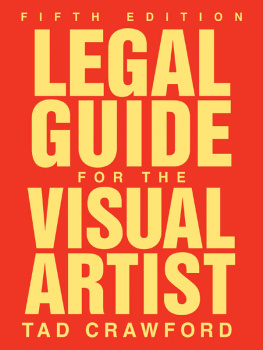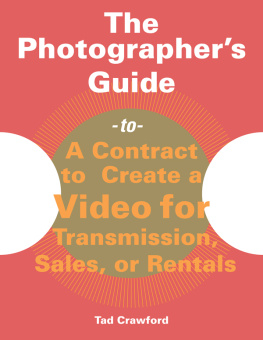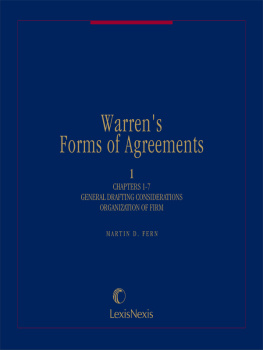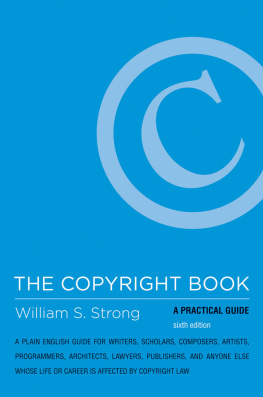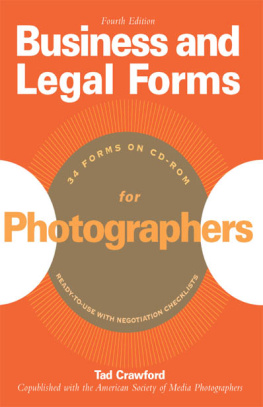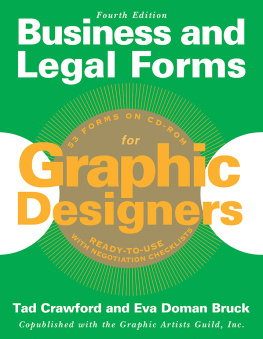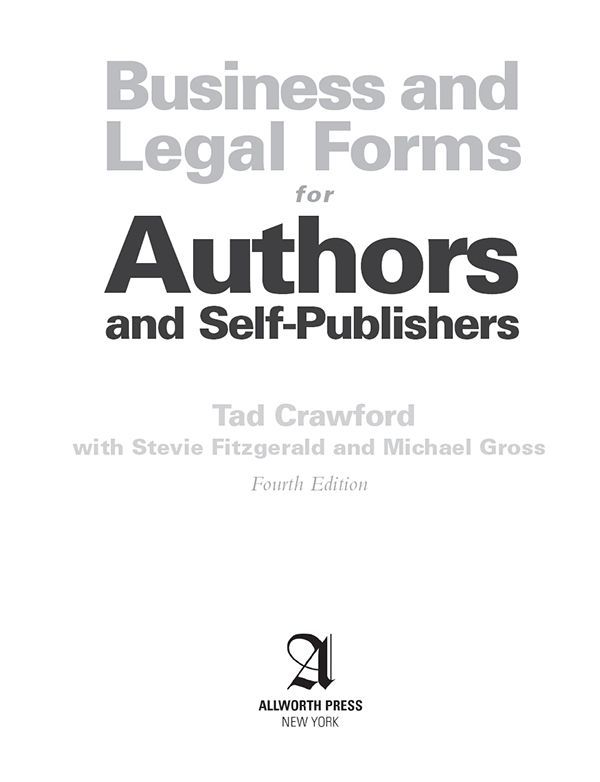for the website and password.
copyright 1990, 1996, 1999, 2004, 2015 by Tad Crawford
All rights reserved. Copyright under Berne Copyright Convention, Universal Copyright Convention, and Pan American Copyright Convention. No part of this book may be reproduced, stored in a retrieval system, or transmitted in any form, or by any means, electronic, mechanical, photocopying, recording or otherwise, without the express written consent of the publisher, except in the case of brief excerpts in critical reviews or articles. All inquiries should be addressed to Allworth Press, 307 West 36th Street, 11th Floor, New York, NY 10018.
Allworth Press books may be purchased in bulk at special discounts for sales promotion, corporate gifts, fund-raising, or educational purposes. Special editions can also be created to specifications. For details, contact the Special Sales Department, Allworth Press, 307 West 36th Street, 11th Floor, New York, NY 10018 or .
15 14 13 12 11 5 4 3 2 1
Published by Allworth Press, an imprint of Skyhorse Publishing, Inc. 307 West 36th Street, 11th Floor, New York, NY 10018.
Allworth Press is a registered trademark of Skyhorse Publishing, Inc., a Delaware corporation.
www.allworth.com
Cover and interior design by Douglas Design Associates, New York, NY.
Book design by Douglas Design Associates, New York, NY.
Printed in China.
Library of Congress Cataloging-in-Publication Data is available on file.
Print ISBN: 978-1-62153-464-8
Ebook ISBN: 978-1-62153-475-4
This book is designed to provide accurate and authoritative information with respect to the subject matter covered.
It is sold with the understanding that the publisher is not engaged in rendering legal or other professional services.
If legal advice or other expert assistance is required, the services of a competent attorney or professional person should be sought. While every attempt is made to provide accurate information, the author or publisher cannot be held accountable for errors or omissions.
Table of Contents
Please note the forms in this book can be downloaded and customized from the Internet. See for the website and password.
How to Use the Forms
Introduction
A ttaining the knowledge of good business practices and implementing their use is an important step toward success for any professional, including the professional author. The forms contained in this book deal with the most important business transactions that an author is likely to undertake. The fact that the forms are designed for use and that they favor the author give them a unique value. To access digital files of the forms from this book, please visit www.skyhorsesupplements.com. Navigate to the page for the Business and Legal Forms series in the Allworth Press section, and search for the title Business and Legal Forms for Authors & Self-Publishers . The password to download the files is: s2TrUqus.
Understanding the business concepts behind the forms is as important as using them. By knowing why a certain provision has been included and what it accomplishes, the author is able to negotiate when faced with someone elses business form. The author knows what is and is not desirable. The negotiation checklists offer a map for the negotiation of any form.
All forms, whether the authors or someone elses, can be changed. Before using these forms, the author should consider reviewing them with his or her attorney. This provides the opportunity to learn whether local or state laws may make it worthwhile to modify any of the provisions. For example, would it be wise to include a provision for arbitration of disputes, or are the local courts speedy and inexpensive, making an arbitration provision unnecessary?
The forms must be filled out, which means that the blanks in each form must be completed. Beyond this, however, the author can always delete or add provisions on any form. Deletions or additions to a form are usually initialed in the margin by both parties. It is also a good practice to have each party initial each page of the contract, except the page on which the parties sign.
The author must ascertain that the person signing the contract has authority to do so. If the author is dealing with a company, the companys name should be included, as well as the name of the individual authorized to sign the contract and the title of that individual. If it isnt clear who will sign or if that person has no title, the words Authorized Signatory can be used instead of a title.
If the author will not be meeting with the other party to sign the contract, it would be wise to have that party sign the forms first. After the author gets back the two copies of the form, they can be signed and one copy returned to the other party. As discussed in more detail under letter contracts, this has the advantage of not leaving it up to the other party to decide whether to sign and thus make a binding contract.
If additional provisions that wont fit on the contract forms should be added, simply include a provision stating, This contract is subject to the provisions of the rider attached hereto and made a part hereof. The rider is simply another piece of paper, which would be headed Rider to the contract between ________________________________ and ______________, dated the ____ day of _________, 20____. The additional provisions are put on this sheet and both parties sign it.
Contracts and Negotiation
Most of the forms in this book are contracts. A contract is an agreement that creates legally enforceable obligations between two or more parties. In making a contract, each party gives something of value to the other party. This is called the exchange of consideration. Consideration can take many forms, including the giving of money or writing or the promise to create writing or pay for writing in the future.
Contracts require negotiation. The forms in this book are favorable to the author, so changes may be requested. This books explanation of the use of each form should help the author evaluate changes either party may want to make in any of the forms. The negotiation checklists should also clarify what changes would be desirable in forms presented to the author.
Keep in mind that negotiation need not be adversarial. Certainly the author and the other party may disagree on some points, but the basic transaction is something that both want. This larger framework of agreement must be kept in mind at all times when negotiating. Of course, the author must also know which points are nonnegotiable and be prepared to walk away from a deal if satisfaction cannot be had on these points.
When both parties have something valuable to offer each other, it should be possible for each side to come away from the negotiation feeling that they have won. Winwin negotiation requires each side to make certain that the basic needs of both are met so that the result is fair. The author cannot negotiate for the other side, but a wise negotiation strategy must allow the other side to meet their vital needs within a larger context that also allows the author to obtain what he or she must have.
It is a necessity to evaluate negotiating goals and strategy before conducting any negotiations. The author should write down what must be achieved and what can be conceded or modified. The author should try to imagine how the shape of the contract will affect the future business relationship with the other party. Will it probably lead to success for both sides and more business or will it fail to achieve what one side or the other desires?
When negotiating, the author should keep written notes close at hand concerning goals and strategy. Notes should be kept on the negotiations, too, since many conversations may be necessary before final agreement is reached. At certain points the author should compare what the negotiations are achieving with the original goals. This will help evaluate whether the author is conducting the negotiations according to plan.



